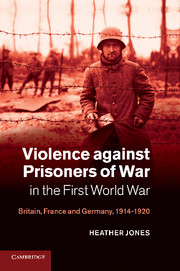Book contents
- Frontmatter
- Contents
- List of illustrations
- List of tables
- Acknowledgements
- Abbreviations
- Introduction
- Part I Propaganda representations of violence against prisoners
- 1 Encountering the ‘enemy’: civilian violence towards prisoners of war in 1914
- 2 Legitimate and illegitimate violence against prisoners: representations of atrocity, 1914–16
- Part II Violence and prisoner of war forced labour
- Part III The end of violence? Repatriation and remembrance
- Glossary of foreign terms
- Bibliography
- Index
2 - Legitimate and illegitimate violence against prisoners: representations of atrocity, 1914–16
Published online by Cambridge University Press: 05 January 2014
- Frontmatter
- Contents
- List of illustrations
- List of tables
- Acknowledgements
- Abbreviations
- Introduction
- Part I Propaganda representations of violence against prisoners
- 1 Encountering the ‘enemy’: civilian violence towards prisoners of war in 1914
- 2 Legitimate and illegitimate violence against prisoners: representations of atrocity, 1914–16
- Part II Violence and prisoner of war forced labour
- Part III The end of violence? Repatriation and remembrance
- Glossary of foreign terms
- Bibliography
- Index
Summary
Great part of the information obtained in war is contradictory, a still greater part is false, and by far the greatest part is of a doubtful character … As a general rule, … everyone is inclined to magnify the bad in some measure.
Carl von Clausewitz, On War.Introduction
In a recent essay on war literature, Bernd Hüppauf described how ‘since the First World War propaganda has stood for the absolute opposite of truth’. Yet, as the previous chapter has shown, the real relationship between representations of violence and wartime experience was much more complex. As the events of 1914 illustrated, violence by civilians against prisoners of war, reported in the media, served to exacerbate the polarisation of European populations and to undermine the legally protected status of the prisoner in wartime. However, this pattern did not stop with civilian violence against prisoners arriving on the home front. Rather it was repeated throughout the first sixteen months of the war, as other incidents of prisoner mistreatment emerged in public discourse in a similar fashion to form cycles of violent representations, which ultimately undermined prisoners' rights, by encouraging lower social and military expectations of how prisoners were to be treated. These early wartime discourses on prisoner mistreatment were closely interrelated and over time they led to widespread cognitive assumptions: by 1915, it had become the norm to depict any prisoner mistreatment by the enemy as an atrocity, regardless of cause, scale or extremity.
- Type
- Chapter
- Information
- Violence against Prisoners of War in the First World WarBritain, France and Germany, 1914–1920, pp. 70 - 120Publisher: Cambridge University PressPrint publication year: 2011

